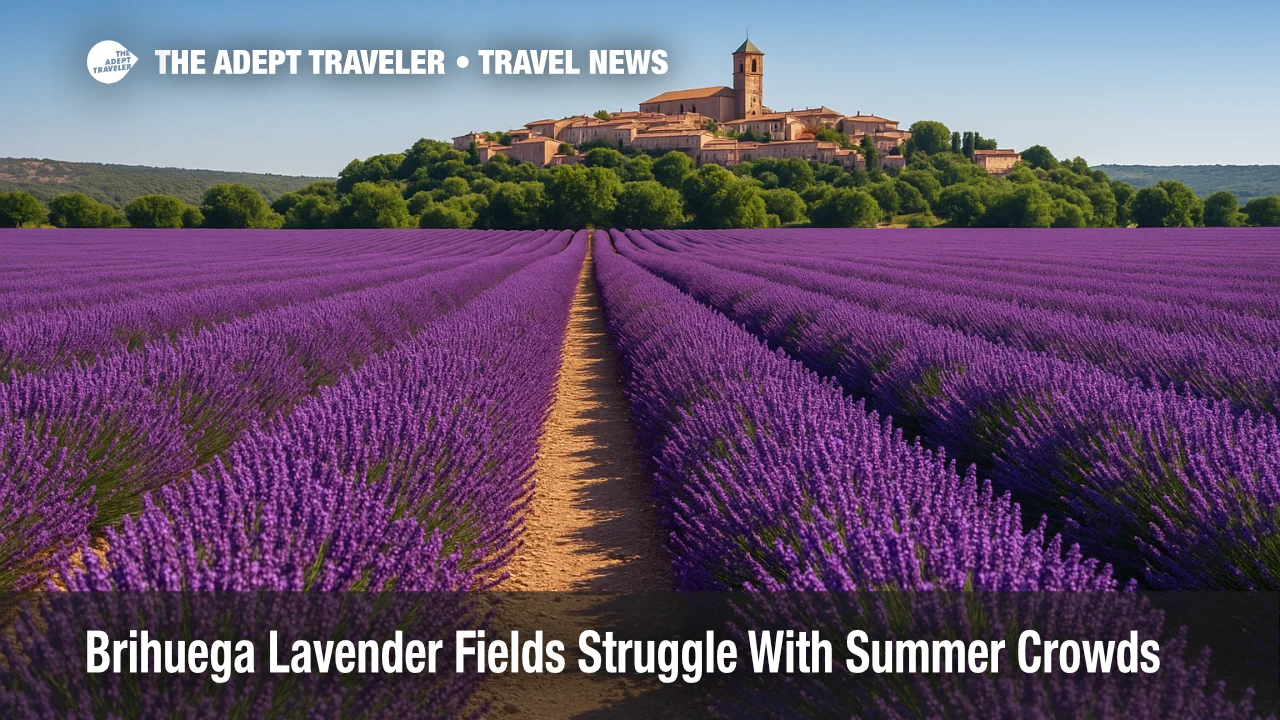Brihuega Lavender Fields Struggle With Summer Crowds

Brihuega, Spain's purple-hued showpiece, drew an estimated 100 000 visitors in July, overwhelming its narrow medieval lanes and prompting officials to warn weekend travelers to stay away. Mayor Luis Viejo says the surge has become unmanageable despite the flower's economic importance, forcing the town to fast-track crowd-control plans. Local leaders now face a dilemma familiar to Europe's hot spots: protect a vital revenue stream while preserving residents' quality of life.
Key Points
- Why it matters: Brihuega's one-month bloom spotlights Europe's wider overtourism crisis.
- Peak-season footfall topped 100 000 in July, quadrupling the town's population.
- Flower tourism injected €8 000 000 EUR (about $8 720 000 USD) this season.
- Officials propose an out-of-town park-and-ride with shuttle buses for 2026.
- Mayor urges mid-week visits to ease weekend gridlock.
Snapshot
Set amid the rolling hills of Guadalajara province, Brihuega cultivates roughly 1 000 hectares of lavender that burst into color each July. Instagram helped turn the once-sleepy farming community into a photogenic pilgrimage, reversing rural depopulation and boosting the tax base. Population has risen 24 percent over ten years, and new cafés, guesthouses, and artisan markets thrive on bloom-season spending. Yet infrastructure-single-lane streets, limited parking, and 18th-century plazas-was never built for coachloads of day-trippers. Residents now face traffic jams, litter, and blocked driveways during the busiest weekends.
Background
Brihuega launched its Lavender Festival in 2012 to diversify local agriculture and promote slow tourism. Early visitors numbered in the low thousands, but viral images of endless purple rows soon spread across social media. By 2021, the town welcomed about 60 000 July guests; that figure has since doubled. Entry to the fields remains free, a deliberate policy to keep the experience inclusive, but it also removes levers-such as timed tickets or tourism taxes-that other attractions use to cap numbers. Neighboring villages benefit from spill-over spending, yet local council budgets are strained by traffic management, public-safety staffing, and road repairs.
Latest Developments
Park-and-Ride Plan Targets 2026 Bloom
Town hall has approved land acquisition for a 500-vehicle park-and-ride just outside the walled center. Shuttle buses will loop between lots and the main viewpoints every 15 minutes, reducing congestion on medieval streets where two cars barely pass. Officials expect the €1 200 000 outlay to be offset by parking fees and reduced road maintenance. Final engineering studies begin in September, with construction scheduled after the 2025 harvest.
Mayor Urges Mid-Week Visits to Ease Gridlock
"Last Saturday we collapsed," Mayor Viejo told Spain's ABC newspaper. He now pleads for travelers to arrive Monday through Thursday when daily counts average 3 000, compared with 20 000 on peak Saturdays. The municipal website, local hotels, and tour operators will highlight quieter slots and bundle mid-week discounts to spread demand. If voluntary shifts fail, officials may explore reservation systems akin to those used at Mount Fuji and other fragile sites.
Year-Round Tourism Strategy Takes Root
To avoid a one-month boom-and-bust cycle, Brihuega is marketing autumn's crimson sumac fields and December's artisanal candle fair. Winter culinary weekends and spring wildflower walks aim to keep guesthouses open beyond July, stabilizing employment. Spain's recent Barcelona overtourism protests underscore the value of dispersing travelers both geographically and seasonally.
Analysis
Brihuega's dilemma mirrors hotspots from Cinque Terre to Hallstatt: viral scenery draws revenue but also crowds that erode the very charm visitors seek. The town's free-access model reflects a community mindset that tourism should benefit all, yet it leaves few tools for demand management. Without timed tickets or entry fees, soft measures-parking controls, shuttle buses, and marketing nudges-must shoulder the burden. Comparable rural attractions have succeeded with tiered pricing that favors early or late arrivals while funding maintenance. Brihuega's decision to invest in a park-and-ride is a pragmatic first step, but its success hinges on strict enforcement and real-time traffic data. Broader overtourism solutions require regional coordination: rail service upgrades, joint festivals that stagger bloom dates, and storytelling that elevates nearby villages. For travelers, mid-week visits not only reduce stress but also deepen engagement with local artisans uncluttered by weekend crowds. Long term, turning the lavender rush into sustainable, year-round tourism will define whether Brihuega remains a rural revival success or another cautionary tale.
Final Thoughts
Brihuega's purple panorama still delivers extraordinary photos and fragrant memories, yet respectful timing is now part of the itinerary. Travelers who choose quieter weekdays, support local businesses, and follow parking guidance help ensure the flowers remain a gift, not a grievance, for the community that stewards them. Plan ahead, stroll lightly, and savor the scent-your effort will keep the magic blooming at the Brihuega lavender fields.
